USB charging types. USB Type-C: Universal connector for all. What are the advantages of a universal serial tire
The presence of USB connectors on digital devices has long been perceived as a triam and banality. However, this technology I gained mass distribution only from the mid-2000s, sweating popular before the LPT, PS / 2, COM port and other outdated specifications. Starting with 1,5 Mbps bandwidth, USB passed several stages of its formation, and now we expect the appearance of the USB 3.2 standard with the bandwidth of more than 1 Gbit / c. In this case, the USB connector has various forms and modifications, which I dedicate descriptions this materialwhich will tell you what exist types of USB Connectors, what is their specificity and for which purposes are universal serial tires.
The main versions of USB connectors
There are three main types of USB connections (USB 1.0, USB 2.0, USB 3.0), while each of the versions survived several more specifications. Before the appearance of the type 1.0 officially existed the SSB specifications number 0.7, 0.8, 0.9, and even 0.99. Specification 1.0 had a branch 1.1, which was the first truly massive and popular Yusb connector. Modern Specification 3.0 continued its development in version 3.1, the Specification 3.2 is also prepared for the output.
At the same time, each of the main specifications has its own characteristic features, on which I fighter your attention.
USB 1.0 connector
As you know, the appearance of the USB connector has become a response to the desire of various IT companies (Intel, Microsoft, etc.) to expand the functionality of the computer, congruently connect to the PC mobile phone, as well as make a new connector simply and convenient for the user.
Seeing the light in the mid-90s, the USB connector at first was not very popular. Humorists even invented a parallel decoding of its abbreviation as a "useless serial bus" (useless sequential tire). Nevertheless, passing several stages of their formation, the version of YUSB 1.1 began to win the market at the end of the 90s.

Characteristics of this specification were more than modest: Low transmission rate (12 Mbps), maximum length cable 5 meters, voltage peripheral devices In 5 volts and the maximum current of 500 mA. By appearance It practically did not differ from his heir - a connector of the type 2.0.
USB 2.0 connector
The most common, mass and popularity has acquired YUSB-cord 2.0 (type A), which was released in the spring of 2000. In most modern stationary computers and leptopes, there are several such connectors through which we connect to PC various peripheral devices - from the printer, flash drives, keyboards to a regular computer mouse.

The speed of the U-ES-BI 2.0 interface was a good figure - in 480 Mbps, which allowed with the maximum benefit to use it in modern computer technician.
USB 3.0 connector
This version of the specification appeared in 2008, and since then is actively introduced into the functionality of modern PCs. The data transfer rate here significantly increased - up to 5 Gbps, the current strength (up to 900 mA) increased, which made it possible to feed more devices from one port.
Usb connectors version 3.0 are easy to distinguish from other connections - they are painted in blue (occasionally in red), and immediately rush into the eyes.

Compatibility of USB connectors
If we are talking about the compatibility of the SUB connections with each other, then the first and second type of USB connector are compatible with each other. If you connect a device created to work with USB 2.0 in the connector 1.1, the user will receive a system message that this device can work faster (it will work, although not as fast as it were from 2.0).
 Message "This device can work faster"
Message "This device can work faster" The Usb 2.0 and 3.0 connectors are also partially compatible, you can calmly stick the device designed for 2.0 connector in the 3.0 connector, and it will work. In this case, the device intended for the connection of the type 3.0 in the connector 2.0 you will not be able to stick.
Types of USB connections
There are also various versions of USB connectors. Below I will describe the most common options.

USB 2.0, type A
The most massive option that can be found almost from any PC user. It is wear-resistant, has a high margin of strength, withstands great amount Connections, possesses "fool protection" (you will not be able to stick it with the opposite side). At the same time, in portable techniques, it is usually not used, as it has impressive, as for these devices, sizes.

USB 2.0, type B
Usually possesses a trapezoidal (or square) form. It also has considerable sizes, therefore applied in relatively large peripheral devices (scanners, printers, etc.).

MINI USB 2.0 (type B modification)
Having reduced (compared to the above connectors) dimensions, applied mainly in portable technique (for example, in players, portable hard drives, cartriders, etc.). It has 5 contacts, not 4 as a classic yusb, and 1 contact is not used.
The disadvantages include exposure to destruction (with active use of the connector, the latter regularly fails).

Micro USB 2.0 (type B modification)
Superior view of MINI USB connector. Has minimal sizes, and great for a whole range small devices - from mobile phones and tablets to digital cameras. In this case, it guarantees excellent contact, wear-resistant, has good prospects to become a universal type of connectivity for the absolute majority of electronic devices.

Distinguish the Micro USB (connector under review) from mini usb is simple enough. Micro USB has two latches on the back of which the MINI USB connector is deprived.

USB 3.0 (type A)
Modored Standard YUSB 3.0 A, as a result of greater speed, is actively used in laptops and fixed computers of the last generation.
USB 3.0 (type B)
Cords and devices of this version can no longer connect to the standard SW 2.0 connector. This type The connector is used when operating devices with high performance.
Micro USB 3.0

Used to work speed SSD drives, external high-speed drives, provides very high quality connections.
Video
The main types of USB connections applied today are still the most massive versions of USB 2.0, and actively used in modern devices USB 3.0 versions. Progress does not stand still, and quite soon we have the appearance of YUSB 3.2, which will raise the speed of working with data to 1 Gbit / c. The next step in the development of the popular interface is no longer behind the mountains.
New standard USB Type-C. It is still not widely developed in the market, but manufacturers gradually accept fresh technology. In the USB-C smartphone, you can already be called a new trend, because it is not only an improved charging connector, but also a means for refusing a traditional 3.5-millimeter headphone port. Today we will talk in more detail about USB Type-C, and this article will tell you what it is.
Today almost everyone electronic devices Equipped with USB connector. From desktops to smartphones and a variety of drives with laptops. USB is an ubiquitous standard when it comes to connecting the periphery or data transmission between devices. The last major update of the USB was published in 2013 with the output of USB 3.1, accompanied by the release of the new Type-C connector. As you can see, since then almost 4 years has passed, and Type-C never passed.
Currently, in the market, you can recalculate devices using devices using uSB technology Type-c. Among the computers is the latest Apple laptops, from Google, Samsung ruler and a few more hybrid devices. Among smartphones - mostly flagships of the outgoing year:, and.
So why is USB Type-C better than predecessors? Let's find out.
What is USB Type-C

USB Type-C is a new and currently actively developing sectoral data standard for computers and mobile devices. The main and most significant innovation of Type-C is a modified connector - a universal, symmetrical, capable of working by any side. USB-C connector was invented by USB IMPLEMENTERS FORUM - a group of companies that developed and certified new standard USB. It also includes the largest technological companies, namely, Apple, Samsung, Dell, HP, Intel and Microsoft. By the way, it is important to know, because therefore USB Type-C was easily accepted by most PC manufacturers.
USB-C is a new standard
First of all, you need to know that USB Type-C is a new standard for the industry. In the same way as they were usb 1.1, USB 2.0, USB 3.0 or the latest USB 3.1. Only previous generations of USB were more focused on increasing the rate of data transfer and various other improvements, while Type-C from a physical point of view changes the design of the connector similarly to the modifications of the technology - MicroUSB and MINIUSB. However, the decisive difference in this case is that, unlike microusb and miniusb, Type-C is aimed at replacing absolutely all standards, and from both sides (an example of USB-microusb).Main characteristics:
- 24 signal output
- USB support 3.1.
- Alternative mode to implement third-party interfaces
- Speed \u200b\u200bup to 10 Gbps
- Energy transmission up to 100 W
- Dimensions: 8,34х2,56 mm
USB Type-C and USB 3.1
One of the possible questions of those who do not know about USB Type-C may be something similar: what does USB 3.1 ratio have to USB Type-C? The fact is that USB 3.1 is the main data transfer protocol for Type-C. The speed of version 3.1 is 10 Gbps per second - in theory it is 2 times faster than USB 3.0. More USB 3.1 can be presented in the original connector format - this port is called USB 3.1 Type-a. But today it is much easier to meet USB 3.1 with a new Type-C universal connector.USB version
To better understand why Type-C becomes replacing the traditional version of USB, first of all it is necessary to understand the difference between them. There are various USB versions, as well as even different connectors - for example, Type-a and Type-b.USB versions belong to the general standard, but their difference consists in the maximum data transfer rate and capacity of the work. Of course, there are many other factors.
USB 1.1.
Although USB 1.0 is technically the first version of the USB, it could not fully enter the market. Instead of it was released a new version USB 1.1 - just she became the first standard to which we were all accustomed. USB 1.1 may transmit data at a speed of 12 Mbps per second and consumes 100 mA currents.
USB 2.0
The second USB version was presented in April 2000. It provided a standard for significant increase in the maximum data transfer rate - up to 480 Mbps per second. Also, USB 2.0 has become more powerful by consuming 1,870 by 2.5V.
USB 3.0.
USB 3.0 yield brought with you not only the expected improvements in data transmission and power, but also new types of connectors. Moreover, USB 3.0 even got his color - the new version of the standard was designated blue to distinguish it from old USB generations. USB 3.0 can operate at a speed of up to 5 Gbps per second, taking 5V for its operation to 1,8a. By the way, this version was presented in November 2008.
USB 3.1.
Newest and Samem best version USB was released in July 2013, although it is still not used everywhere. USB 3.1 can provide users with bandwidth up to 10 Gbps per second with maximum energy consumption in 5V / 1A, or optionally 5A / 12V (60 W) or 20B (100 W).
Type-A.
Type-A is a classic USB interface. Short and rectangular plug has become original design For USB to this day, it remains a standard connector for use at the end of the USB cable host. There are also some variations of Type-A - Mini Type-a and Micro Type-A, but they have never been widely accepted by the public due to the complex socket. Currently, both of these variations of Type-A are recognized as outdated.

Type-B.
If Type-A has become one side of the usb cable familiar to us, then Type-B is another. The original TYPE-B is a high connector with beveled upper corners. Usually occurs on printers, although by itself is an extension of the USB 3.0 standard for introducing new connection capabilities. The classic miniusb and microUSB also exists in the Type-B version, along with absolutely clumsy microUSB 3.0, in which additional plugs are used.
Type-C.
Thus, after Type-a and Type-b, we approached, obviously, to the newest Type-c. Type-a and Type-B versions were to work together with each other by backward compatibility, but the arrival of Type-C completely destroyed these plans, since USB-C implies a complete replacement of outdated USB connection technologies. Also Type-C was designed special to additional options MINI or Micro did not need to release at all. This, again, is associated with the intentions to replace all the current connectors on USB Type-C.

The main feature of the Type-C standard is the versatility or symmetry of the connector. USB-C can be used by both parties like Apple Lightning technology - more than any special sides for the connection, which is also difficult to find in the dark. Also, the Type-C version is based on USB 3.1, which means supporting all the advantages of the latest version, including the highest speed.
USB-C is still inversely compatible with existing USB variants, but for such a use scenario, of course, adapters will need.

USB Type-C Disadvantages
The problems of the new USB Type-C standard are naturally also available. One of the main and most serious concerns of the latest version of the technology is called the physical design of the connector - it is very fragile due to symmetric design. Apple, despite the same versatility of its Lightning, uses a durable metal plug, which is much more resistant to external influences.Even more relevant and considerable concern uSB problem Type-C is the unregulated connection of the connector, which led to a number of dangerous accessories in the sale. Some of these accessories through the use of unsupported voltage levels are able to "fry" the connected device. For example, it was so with magnificent at the start of the flagship, which later began to ignite first, and then explode in the hands, trousers, cars and apartments of their owners.

This problem led to an obvious and only solution - a massive ban on the production and sale of non-original accessories with support for USB Type-C. So, if the accessory does not meet the standard USB IMPLEMENTERS FORUM INC. INC., then the product will not be allowed to sell. Also, to test the working condition and authenticity of various third-party accessories, USB-IF introduced a 128-bit software encryption, which will allow devices with this connector to carry out automatic check Connected device or accessory with USB-C.
Minuses:
- Design.The design of USB Type-C is good, but the design suffered - it is rather fragile. Apple In its Lightning uses a all-metal plug when the oval form is used in Type-C with the placement of signal outputs in the central part.
- Connector operation.If you allow USB Type-C to work with unsupported voltage levels, then most likely the cable and / or the device will be ignited.
- Compatibility.USB Type-C is innovation in the USB world, but the newest generation leaves old devices in the past, because it does not support work with them.
- Adapters.For full-fledged work With USB Type-C on old devices, adapters will have to arrive. This is an extra cost of money.
Advantages of USB Type-C

Despite all the above, USB Type-C can be confidently called a step forward for the industry. Installing this Connector will allow manufacturers to make thinner computers and mobile devices with fewer ports, the highest data transfer rate and headphones. In the future, if USB Type-C is mounted in the mass, the connector will be able to replace not only the port 3.5 mm for headphones, but also the HDMI - the interface used to transmit video. So USB Type-C will replace familiar connectors today and will become a universal standard in any situation.
Pros:
- Symmetry. USB Type-C allows you to forget about situations when you have to remember which side to insert the cable into the connector. From now on, you can not be afraid not to find the desired USB side in the dark.
- Compactness. The dimensions of USB Type-C are 8.4x2.6 mm - it allows manufacturers to make computers and mobile devices significantly thinner.
- Universality. Thanks to the integration of the single connector, it will be possible charging with one cable as a laptop and a tablet or a smartphone.
The USB cable pinout means the description of the internal unit of the universal sequential tire. This device is applied to data transmission and charging batteries of any electronic devices: mobile phones, players, laptops, tablet computers, tape recorders and other gadgets.
High-quality pinout requires knowledge and skills to read schemes, orientation in types and types of connections, you need to know the classification of wires, their colors and purpose. Long and uninterrupted cable operation is ensured by the correct connection with wires 2 connectors USB and mini-USB.
Universal sequential tire is represented by 3 versions - USB 1.1, USB 2.0 and USB 3.0. The first two specifications are completely combined with each other, the tire 3.0 has a partial alignment.
USB 1.1 is the first version of the device used for data transmission. The specification is applied only for compatibility, as 2 data transmission operating modes ( Low-Speed \u200b\u200band Full-Speed) Possess low information exchange. Low-speed mode with a data transfer rate of 10-1500 kbit / s is used for joysticks, mice, keyboards. Full-Speed \u200b\u200bis involved in audio and video devices.
In USB 2.0, the third mode of operation is added - high-speed to connect information storage devices and video devices to a higher organization. The connector is marked with an inscription Hi-Speed \u200b\u200bon the logo. The rate of information exchange in this mode is 480 Mbps, which equals the copy speed of 48 MB / s.
In practice, due to the features of the design and implementation of the protocol, the bandwidth of the second version turned out to be less than the stated and amounts to 30-35 MB / s. The cable and connectors of the specifications of the universal bus 1.1 and second generation have an identical configuration.
The universal third-generation bus maintains a 5 Gb / s speed, equal to the copy speed of 500 MB / s. It is produced in blue color, which makes it easier to determine the membership of the plugs and the nest to the improved model. The power of the current in the tire 3.0 increased from 500 mA to 900 mA. This feature allows not to use individual power supplies for peripheral devices, but to use the bus 3.0 for their power.
Compatibility of Specifications 2.0 and 3.0 is partially executed.
Classification and pickling
In descriptions and notation in the tables of the SUE connectors, it is decided by default that the species is shown from the external, the working side. If a view from the mounting side is submitted, it is stipulated in the description. In the light-gray scheme, the insulating elements of the connector are marked, dark gray - metal parts, cavities are referred to as white.

Despite the fact that the sequential tire is called universal, it is represented by 2 types. They perform different functions and provide compatibility with devices with improved characteristics.
Type A includes active, feeding devices ( computer, Host), to type B - passive, plug-in equipment ( printer, scanner). All sockets and plugs of second-generation tires and version 3.0 type A are designed for collaboration. Third-generation Type b bus jack is larger than needed for a plug version 2.0 type B, so the device with a universal bus connector 2.0 Type B is connected using only USB 2.0 cable. Connecting external equipment with modification connectors 3.0 Type B is performed by cables of both types.
Classic type B connectors are not suitable for connecting small-sized electronic equipment. Connecting tablets, digital technology, mobile phones is performed using miniature mini-USB connectors and their improved modification of Micro-USB. These connectors have reduced plug dimensions and sockets.
The latest modification of the UNSB connectors is Type C. This design has the same connectors at both ends of the cable, has a more high-speed data transmission and greater power.
Pointing USB 2.0 Connector Types A and B
Classic connectors contain 4 types of contacts, in mini and microformats - 5 contacts. Wiring colors in USB cable 2.0:
- + 5V ( red VBus), voltage 5 V, the maximum current of 0.5 A, is intended for nutrition;
- D- ( white) Data-;
- D + ( green) Data +;
- GND ( the black), Voltage 0 V, used for grounding.

For mini format: Mini-USB and Micro-USB:
- Red VBus (+), voltage 5 V, current of 0.5 A.
- White (-), D-.
- Green (+), D +.
- ID - for type A closed on GND, to maintain the OTG function, and do not use for type B.
- Black GND, voltage 0 V, used for grounding.
In most cables there is a shield wire, it has no insulation, used as a screen. It is not marked, and he does not assign a number. The universal tire has 2 types of connector. They have the designation M ( male) and f ( female). Connector M ( dad) Call the plug, it is inserted, the fler F ( mum) It is called the nest, insert it into it.
Molding USB 3.0 Types A and B
Tire version 3.0 has a connection of 10 or 9 wires. 9 contacts are used if there is no shield wire. The location of the contacts is made in such a way that you can connect the devices of early modifications.
Spacking USB 3.0:
- A - plug;
- B - nest;
- 1, 2, 3, 4 - contacts that coincide with pinout contacts in Specification 2.0, have the same color gamut;
- 5, 6 Contacts for data transmission using the Super_Speed \u200b\u200bprotocol, have the designation SS_TX and SS_TX +, respectively;
- 7 - Grounding GND;
- 8, 9 - Wire contact pads for receiving data on the Super_Speed \u200b\u200bprotocol, contact designation: SS_RX- and SS_RX +.

MICRO-USB CONNECTOR SPORT
Micro-USB cable has connections with 5 contact pads. It is supplied to a separate mounting wire in the isolation of the desired color. So that the plug is accurate and tight in the nest, the upper shielding part has a special chamfer. Contacts Micro USB numbered numbers from 1 to 5 and read right to left.
Micro and mini-USB cructures are identical, presented in the table:
The shielding wire is not soldered to any contact.

MINI-USB pinout
MINI-A and MINI-B connectors appeared on the market in 2000, USB 2.0 standard used. Today, the day is little used due to the emergence of more advanced modifications. I replaced the microtinites and models of YUSB type C. In the mini connectors, 4 shielded wires and ID-function are used. 2 Wires are used to power: feeding +5 V and ground GND. 2 Wires for receiving and sending differential data signals are denoted by D + and D-PIN. Data + and Data signals are transmitted by software. D + and D-work always together, they are not separate simplex connections.
The USB connectors use 2 types of cables:
- shielded, 28 AWG twisted, power 28 AWG or 20 AWG without twist;
- unshielded, 28 AWG without twist, power 28 AWG or 20 AWG without twist.

The cable length depends on the power:
- 28 - 0.81 m;
- 26 - 1.31 m;
- 24 - 2.08 m;
- 22 - 3.33 m;
- 20 - 5 m.
Many manufacturers of digital technology are developing and equipped their products with different configuration connectors. This can cause difficulties with charging a mobile phone or other devices.
They are large and small, wide and narrow, rectangular, oval, with cut corners, colored and black and white. They are everywhere: on the phone, on a computer, TV, near the wall outlet, and sometimes even on the chandelier.
They are USB connectors. There are many of them, and they are different. Today we will talk, what are the types of USB connectors and what they differ from each other.
The main characteristics of USB
USB (Universal Serial Bus) decrypt as universal sequential tire Data transfer between devices. For example, between the computer and its periphery - keyboard, mouse, flash drive, printer, scanner, webcam, etc.
Through USB, the connected devices get energy to work and charging, therefore Power banks and chargers are equipped with this type of nests. A steam or two pairs of contacts correspond to the nutrition, which in the schemes are conventionally denoted by VCC or +5 V and GND (Earth). If you carefully look at the connector, you can see that these contacts are longer than the rest. This is done in order for the connection / separation of power and information lines to occur with the disengagement in time, otherwise the data can be transmitted with errors.

2 and more contacts are responsible for the data depending on the USB version. Half of them transmits a signal from the main device (host) to the periphery, and the second half is back.
The USB interface supports Plug and Play technology ("Connect and use"). When connecting to the host, for example, a computer, the peripheral device reports to him that it represents, and the host picks up appropriate driver. "Communication" occurs through the data lines.
The devices released in the last decade are equipped with USB interfaces of versions 2.0, 3.0, 3.1, 3.2. Rarely, but still there are old devices with USB 1.1. Interfaces of different generations transmit information with different speeds.
Theoretically achievable data rates over the USB bus current versions are presented in Table:
| USB1.1 | 12 Mbps |
| USB2.0. | 480 Mbps |
| USB3.0. | 5 Gb / s |
| USB3.1. | 10 Gb / s |
| USB3.2. | 20 Gbit / s |
In order not to confuse the reader, only the maximum speeds are given here, according to specifications. USB various versions excluding their work modes. So, the real rate of data exchange between devices connected to this tire may be at times lower.
USB connectors of different generations are compatible with each other, but the speed of data transmission between them is always limited to the potential of a slower side.
The last - third generation usb is withstanding the current current, rather than the predecessors, which affects the charging speed and maintain the operation of the connected devices, especially consuming a lot of energy, like external hard drives.
The maximum output current of the USB port of the charging or host device is:
- For versions 1.1-0 - 0.5 A.
- For version 3.0 - 0.9-1.5 A.
- For versions of 3.1-3.2 - 1.5-3 A with the ability to increase to 5a.
Standard output voltage USB port - 5 V. Specific versions Specifications 3.1-3.2, focused on connecting energy-intensive devices, withstand up to 20 V.

Externally, the USB connectors of different generations are characterized by flowers. The third is the youngest, has a blue or blue tint, it is his typical sign. The first and second can be painted in black, white, gray and other colors, their coloring is not related to the characteristics.
Types of USB connectors
By destination
By destination, any USB port can be attributed to one of three types:
- Standard or ordinary, which provides meals and information exchange between devices. Such ports are equipped with computers, laptops, smartphones, TVs, etc.
- Charger. They meet on chargerah, Power banks and some system blocksare intended only for powering peripherals.
- Dedicated charger. These nests serve to charge USB gadgets from household power supply. They are embedded in electrical outlets. An example of such a solution is shown in the photo below.

The first type can be any version, the second and third more often refers to versions 2.0 or 3.0. The latter differ in the colors.
By configuration
Connector configuration is also "tied" to generation interface. USB plugs and versions of version 1.1 and 2.0 are the following sizes and shapes:
- Type A (Standard). Such ports are installed on host and chargers. They are three sizes: usual (the most common - 12 × 4 mm, 4 contacts), medium (miniusb 7 × 3 mm, 5 contacts) and small (microUSB 7 × 2 mm, 5 contacts).

- Type B (narrow). The nests of this species are the peripheral equipment. They can also be ordinary (7 × 8 mm, 4 contacts), mini (3 × 7 mm, 5 contacts) and micro (2 × 7 mm, 5 contacts).
The micro-type micro connectors are visually very similar. The only difference is that and has the shape of a rectangle, and the top corners are bevelled.

Rarely, but there are USB cables that are equipped with combined connectors: mini-ab and micro-ab. They can be connected to the nests of the other type.
Third-generation USB connectors have the following sizes:
- A - standard. It differs from the predecessor with the color and number of contacts, here 9. The micro-A connector has 10 contacts and divided into 2 parts. Half is identical to MicroUSB 2.0 (for compatibility), the remaining 5 contacts are located in another part. So done because compact size Did not allow all the conclusions in one place to fit. Mini-a 3.0 connectors do not exist.
- B - its standard and mini connectors are identical to the USB-B configuration version 2.0, but also have 9 contacts. Micro-in MICRO-A form of a form of combined half. It, like MicroUSB-B 2.0, has cut corners.

The MICROUSB interfaces of the third generation are not common, since it is extremely uncomfortable to use. In addition, the nests of this type often do not withstand multiple jerks there and are laid out from the carrier. Their predecessors suffer from the same disadvantage, but here the problem occurs more often.
However, this does not mean that USB-3 miniature connectors will have to abandon. Replacing an unsuccessful solution already found - new and radically unlike prototype uSB interface Type C.
FEATURES USB TYPE C
- This is a third-generation USB compact connector (8.4 x 2.6 mm, 24 of the contact), which is designed for the same tasks as its predecessors. Unlike all other interfaces of this type, it is symmetric or double-sided, that is, it supports connecting the cable and top, and lower parties, as the Lightning connectors on Apple devices.

No need to orient cable in the desired position reduces the risk of breakdowns of the nest, prolongs its service life and simplifies the life of people with weakened vision and disturbed coordination of movements, which, due to these reasons, cannot use devices with MicroUSB-B connectors.
The Type-C specification matches USB 3.1 and provides full compatibility with early versions This interface, as required by the standard. Therefore, mobile gadgets equipped with such nests do not always support third-generation speeds: a new-fashioned connector is quite capable of caring from a USB controller version 2.0.

Another USB-C feature is support for alternative operation modes as HDMI and MHL interfaces (HDMI and MicroUSB hybrid), DisplayPort, VGA and Thunderbolt. Thanks to this chip, the smartphone with Type-C can be connected, for example, to the HDMI port of the TV or DisplayPort input of the computer monitor. Of course, the ability to communicate on such a channel must be implemented in the device with USB-C, which is still found only on top smartphones. However, there is a prospects for technology.
A little about USB cables
Differences between USB cables not only in the configuration of the connectors, but also in the amount of live. The most common cable type is a four-core USB 2.0, designed to transmit data and powering peripheral equipment. In it, each of the lines is associated with a pair of identical contacts on opposite plugs. The data on such a cable is transmitted in turn - or one or the other way.
There are USB cables only for charging. They only have 2 veins - plus and land, and the contacts of information lines are simply connected. They are usually thinner than 4-core. In stores, they usually do not sell them, but include supplying different devices with 5 V power support (for example, electrical toothbrushes).
Third generation USB cables are usually painted in blue (although not always) and thicker. After all, in addition to the standard four lived, they are included as much extra. Due to the supplement lines, simultaneous data transmission in both directions is supported.

To connect to smartphones and tablets of peripheral equipment (keyboards, flash drives, mice, etc.), another cable type has been developed - OTG. In the OTG-2.0 cable only 4 veins and 5 contacts. On the side of the host, an additional - the fifth contact (ID) is connected to the ground - so the devices determine which of them acts as a host. In OTG-3, respectively, on 4 data lines more.
USB Type-C cables On the opposite side, more often have a plug of another kind, for example, USB-A, HDMI, DP, etc. Configuration of the second connector, the amount of lived and communication with certain conclusions, support for the current different levels Define their purpose and functionality.
Cable selection affects the charging speed and information exchange between devices. A poor-quality or incorrectly chosen, it can be a "bottle throat" connection. So, if you connect the phone and computer through the USB-3.0 ports - USB-C cable USB-2.0, the connection will be slower than if the version 3 connector would be used.
Power through a USB connector
Initially, the USB standard was "sharpened" to power and charge low-power devices with a consumption current to 0.5 A at a voltage of 5 V. However, with the advent of smartphones and tablets with high-capacity batteries, this limit would become an irresistible barrier to a mass release to the market. After all, it is possible to charge such devices with small currents, you can move day, and who will like it.
Thus, several more specifications appeared, including Quick Charge. (Fast charging) - energy transfer technology that exceeds regular uSB capabilitiesvia a USB interface.

Today the following versions of this standard are relevant:
- Quick Charge 2.0. It provides a stepped increase in the output voltage from 5 V to 9 V, 12 V and 20 V.
- Quick Charge 3.0. Also maintains an increase in voltage up to 20 V, but with an interval of 0.2 V.
- QUICK CHARGE 4.0 and 4+. Based on another power supply technology - Power Delivery, and provides fast charging Batteries via USB-C connectors.
The ability to replenish energy reserves from Quick Charge charging devices have only those gadgets, where it is implemented at the hardware level. QC technology, like USB, fully supports back compatibility.
Power Delivery- The power supply standard for power-intensive power supports up to 100 W through a conventional cable and USB connectors version 2.0 or 3.0-3.2. The source of energy in such a system may be not only a charger or power Bank., but also a device acting as a host. A host can be assigned any gadget with a battery, such as a smartphone connected to another smartphone.
Current transmission in Power Delivery systems is in both directions, so the host and peripherals in the charging process can vary in places. In addition, the standard provides for the possibility of changing the current levels and stresses in five profiles:
- less than 5 V and 2 A;
- 5-12 V and 1.5 A;
- 5-12 V and 3 A;
- 12-20 V and 3 A;
- 12-20 V and 4.75-5 A.
Power Delivery already now allows you to feed through USB connectors such powerful devices like laptops and monoblocks. Further development technologies, it should be expected, will overstep 100-watt threshold and will find use in smart TV, household appliances, lighting devices and wherever possible. In short, the USB has a great future, and we have to coexist with him many more years.
Figured out? Surprised that different species USB so much? 😉
This article provides general information About USB standard as well plotovkaUSB connectoraccording to the colors of all kinds (USB, Mini-USB, Micro-USB, USB-3.0).
USB connector (Universal Serial Bus) - This is a serial universal tire, a modern way of connecting external devices to personal computer. Replaces previously used connection methods (serial and parallel port, PS / 2, Gameport, etc.) for conventional mode of peripherals - printers, mice, keyboards, joysticks, cameras, modems, etc. Also, this connector allows you to organize data exchange between the computer and the camcorder, the card reader, the MP3 player, an external hard disk.
The advantage of USB connector in front of other connectors is to connect plug & Play devices without the need to restart the computer or manual installation Drivers. Plug & Play devices can be connected during computer operation and take up operation within a few seconds.
When connecting a new device, first hub (cable hub) gets high level According to the data transfer line, which reports that new equipment appeared. The following steps are followed:
- Hub reports a host computer that a new device has been connected.
- The host computer requests a hub, which port is connected to the device.
- After receiving the answer, the computer gives the command to activate this port and reset (reset) the tire.
- The hub generates a reset signal (reset) with a duration of 10 ms. The output current of the device is 100 mA. The device is now ready to work and has the default address.
Creating a USB is the result of cooperation of companies such as COMPAQ, NEC, Hewlett-Packard, Philips, Intel, Lucent and Microsoft. USB Standard was called up to replace the widely used Serial RS-232 port. USB as a whole makes it easier for the user and has a greater bandwidth than the RS-232 serial port. The first USB specification was developed in 1995, as an inexpensive universal interface for connecting external devices that did not require greater data bandwidth.

Three versions of USB
USB 1.1.
Version USB 1.1 was designed to maintain slow peripheral devices (low-speed) with a data transfer rate of 1.5 Mbps and fast devices (FULL-SPEED) with a data transfer rate of 12 Mbps. USB 1.1, however, was unable to compete with a high-speed interface, for example. FireWire (IEEE 1394) from apple companies With the data transfer rate of up to 400 Mbps.
USB 2.0
In 1999, they began to think about the second generation of USB, which would be applicable for more complex devices (for example, digital video cameras). This new version, designated as USB 2.0, was released in 2000 and provided the maximum speed of up to 480 Mbps in Hi-Speed \u200b\u200bmode and saved backward compatibility with USB 1.1 (data type: Full-Speed, Low-Speed).
USB 3.0.
The third version (indicated also as Super-Speed \u200b\u200bUSB) was designed in November 2008, but probably due to the financial crisis, its mass distribution was postponed until 2010. USB 3.0 has more than 10 times high speed compared to USB 2.0 (up to 5 Gbps). New development has 9 wires instead of the initial 4 (data bus already consists of 4 wires), however, this standard still supports USB 2.0 and provides reduced power consumption. Due to this, you can use any combination of USB 2.0 devices and ports and USB 3.0.
USB connector has 4 contacts. The twisted pair (twisted two wires) is connected to Data + and Data- contacts, and conventional wires are connected to the VCC outputs (+5 c) and GND. Then the entire cable (all 4 wires) is shielded by aluminum foil.
Below is a pinout (decay) of all types of USB connectors.
Types and pinout USB connectors
Spacking USB cable in colors:

- +5 Volt.
- -Data.
- + Data.
- Common
USB connector pinout circuit - type A:


USB connector pinout circuit - type in:


Spacking cable by colors of connectors: Mini (mini) and micro (micro) USB:
- +5 Volt.
- -Data.
- + Data.
- Not used / general
- Common
Pickup MINI-USB Connector - Type A:


 How to pay a domain name
How to pay a domain name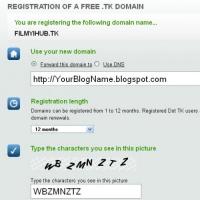 Domain zone of tokelau islands
Domain zone of tokelau islands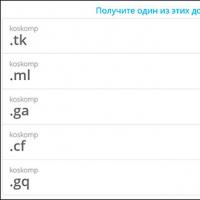 What is domain what problems may be
What is domain what problems may be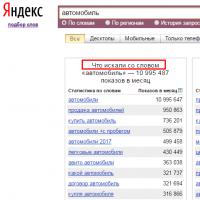 Yandex Wordstat: detailed instructions for using the service and grouping operators and a complicated request
Yandex Wordstat: detailed instructions for using the service and grouping operators and a complicated request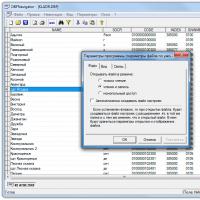 Editing DBF files
Editing DBF files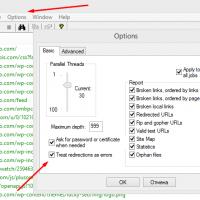 Xenu Link Sleuth - What is this program how to use the Xenu program
Xenu Link Sleuth - What is this program how to use the Xenu program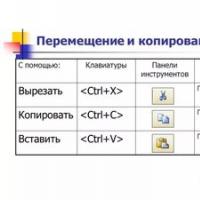 Methods Copy and insert text from keyboard without using mouse
Methods Copy and insert text from keyboard without using mouse